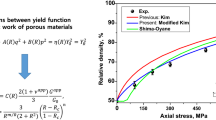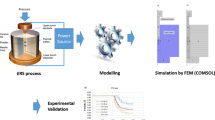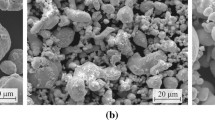A powder body model has been developed to study mass transfer through movement of the material as sliding blocks (packs) simulating particles and grains in polycrystals. The key model parameters are grain size and mobility of intergranular boundary layers. The theoretical analysis has resulted in mathematical relations showing that transfer of the material to fill the pores intensifies with transition to finer grains (subgrains, particles) and with higher mobility of the material in boundary layers between the grains. The boundaries between grains and particles experience greater heating during electric current sintering. Temperature in the boundary zone remains higher than the area far from the boundaries, consequently leading to greater mobility of the material. This improves intergranular slip and promotes fast and ultrafast shrinkage.




Similar content being viewed by others
References
S.-J. L. Kang, Sintering. Densification, Grain Growth, and Microstructure, Elsevier, Amsterdam (2005), p. 265.
A. V. Kuz’mov, E. A. Olevskii, and E. V. Aleksandrova, “Effect of micrononuniform heating of powder in field-assisted sintering on shrinkage kinetics,” Powder Metall. Met. Ceram., 51, No. 11–12, 657–665 (2012).
V. I. Spitsyn and O. A. Troitskii, Electroplastic Metal Deformation [in Russian], Nauka, Moscow (1985), p. 159.
V. B. Fiks, “On interaction of conduction electrons with single dislocations in metals,” Zh. Éksp. Teor. Fiz., 80, No. 6, 2312–2316 (1981).
J. P. Hirth and J. Lothe, Theory of Dislocations, McGraw Hill, New York (1968).
M. P. Volarovich and A. M. Gutkin, “Viscoplastic flow within the body between two parallel flat walls and in the annulus between two coaxial tubes,” Zh. Tekh. Fiz., 16, No. 3, 321–328 (1946).
J. G. Oldroyd, “Non-Newtonian flow of liquids and solids,” in: F. R. Eirich (ed.), Rheology: Theory and Applications, Academic Press, New York (1956).
W. Prager, “Finite plastic deformation,” in: F. R. Eirich (ed.), Rheology: Theory and Applications, Academic Press, New York (1956).
J. Fleeman and G. J. Dienes, “Mechanical properties of metals,” in: F. R. Eirich (ed.), Rheology: Theory and Applications, Academic Press, New York (1956).
F. N. Rhines, W. E. Bond, and M. A. Kissel, “Grain boundary creep in aluminum bicrystals,” Trans. Amer. Soc. Met., 28, 919–951 (1956).
A. N. Orlov, “Material creep,” in: Physical Encyclopedic Handbook [in Russian], Sovetskaya Entsiklopedia, Moscow (1965), Vol. 4, pp. 90–92.
R. W. K. Honeycomb, The Plastic Deformation of Metals, Edward Arnold Ltd, London, UK (1968).
F. A. McClintock and A. S. Argon, Mechanical Behavior of Materials, Addison-Wesley, Reading, Massachusetts (1966).
M. N. Rahaman, Ceramic Processing and Sintering, Marcel Dekker, New York (2003).
R. Chaim and Z. Shen, “Grain size control by pressure application regime during spark plasma sintering of Nd–YAG nanopowders,” J. Mater. Sci., 43, 5023–5027 (2008).
M. Cologna, B. Rashkova, and R. Raj, “Flash sintering of nanograin zirconia in 5 sec at 850°C,” J. Am. Ceram. Soc., 93, No. 11, 3556–3559 (2010).
Author information
Authors and Affiliations
Corresponding author
Additional information
Translated from Poroshkovaya Metallurgiya, Nos. 9–10 (505), pp. 23–34, 2015.
Rights and permissions
About this article
Cite this article
Raichenko, A.I. Electric Current Activated Sintering of Porous Powder Compacts. Powder Metall Met Ceram 54, 525–533 (2016). https://doi.org/10.1007/s11106-016-9745-8
Received:
Published:
Issue Date:
DOI: https://doi.org/10.1007/s11106-016-9745-8




